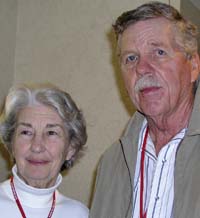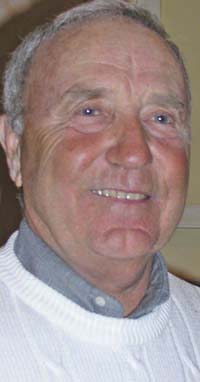The national Tree Fruit Technology Road Map underlined the need to produce higher quality fruit at lower cost, if the U.S. tree fruit industry is to remain competitive. And it identified new technology as the way to accomplish that. We asked fruit growers from across the country to tell us from which technology they could benefit most from.

Dave Allan, Yakima, Washington
New varieties and rootstocks
New varieties and rootstocks will have a greater impact on all the tree fruit industries‹apples, pears, and cherries‹than new machines or computers, Allan believes.
New technology, such as marker-assisted selection and an understanding of the genetic make up of the fruit, will help fruit breeders develop the kind of varieties that consumers want.
A secondary benefit of such technology would be the ability to develop varieties with disease and insect resistance, he said. “That’s going to be a tremendous benefit.”
Allan, a partner at the fruit growing and packing operation Allan Brothers, said it’s encouraging that scientists from around the country are collaborating towards that goal, but he found it disconcerting that President George Bush has proposed to cut funding for agricultural research.

Phil Baugher, Aspers, Pennsylvania
Robotics
Baugher said a robotic device that first of all makes a digital map of the tree canopy to locate fruit and limbs in preparation for thinning or picking the fruit would be a useful and versatile technological advance.
The citrus industry is developing such a device. After mapping the canopy, the machine’s multiple arms should be able to pick fruit, thin fruit, or even prune limbs, the developers say. The machine might also be able to assess crop load or fruit size.
“I always thought that with robotics you would have to have a machine that would go in and make real-time decisions,” Baugher said. “But the way it was presented was that there would be an operation where the cameras would provide a map of the tree and the location of the fruit. Once you have a map of the architecture of the tree, and all the trees within the block, it provides numerous opportunities to mechanize.”

Howard and Jean Albano, Cuyama, California
Picking platforms
Jean and Howard Albano say they’re interested in picking platforms as a way to address labor shortages they expect to face at their organic apple orchard.
“We’re much more worried about labor than the market,” Howard said.
They haven’t had to deal with labor problems up to now, but they worry that crackdowns on immigration will constrict the supply of workers from Mexico. The Albanos have 17 full-time workers but need up to 150 workers during harvest. They depend on migrants from Mexico for thinning and picking, and think a platform might help reduce labor needs.
“I don’t know if it would pencil out, but that’s something that catches our eye,” Jean said. “We don’t have trees that have been designed with that in mind. I don’t know if it would be feasible to use it.”

Darrel Oakes, Lyndonville, New York
Cheaper trees
Lower-cost trees would benefit him the most, Oakes said. “That would allow me to adopt some higher densities from an economic standpoint.”
He has 230 acres of apples, mostly on a 6- by 12-foot spacing.
The high cost of trees is an obstacle to renovation and the greatest deterrent to replanting, he said.
“I look at the potential for efficiency. Being a medium- to small-size grower, the best way for me to increase efficiency is to increase my production of high-quality apples per acre with a given amount of acreage. I need to continue to intensify tree numbers.”
Oakes said he needs to increase production efficiency in order to reduce the cost per bushel.
“Certainly, we’re looking at adopting platforms, but to me that’s only going to be an incremental increase in efficiency that in the long run doesn’t contribute a lot to the bottom line.”

Dennis Courtier, Lake City, Minnesota
Real-time fruit quality testing
Apple grower, packer, and marketer Dennis Courtier thinks the ability to accurately assess the eating quality of each fruit in real time would be of most benefit.
“It’s really all about delivering the perfection of eating quality,” he said. “This is on the verge of happening.”
A number of large fruit shippers are incorporating nondestructive internal quality testing equipment on their packing lines in an effort to assure high fruit quality.
“I think this is going to mean a lot‹being able to deliver the goods time after time after time, no compromises,” Courtier said.

Ed Wittenbach, Belding, Michigan
Better varieties
Wittenbach thinks the industry would benefit most from new varieties that have better eating quality, storability, and shelf life.
“We’re dealing with a customer who wants the finest, and we rely on the customer for our living,” he said.
Wittenbach is confident that superior varieties will be developed.
“I think genetics is a tool that will be used eventually,” he said. “But it’s going to be a few years yet. In the meantime, we’re going to have to use traditional breeding programs to obtain these varieties.”
Wittenbach grows 16 varieties, with Fuji and Honeycrisp in his recent plantings. He’s interested in a new release from the University of Minnesota that will be available to growers on a limited basis.
“Club varieties‹I don’t know if they’re good for the whole industry, but I think for the individuals growing them, they’re the way to go,” he commented.

Del Feigal, Vantage, Washington
Mechanically assisted harvesting
Auvil Fruit Company has been putting workers on moving platforms for the past 15 years to do pruning, thinning, tree training, and hanging of pheromone dispensers. The only job not done from the platform is picking, but that’s about to change.
The company is now developing a platform that pickers can work from, said Del Feigal, manager of the company’s Vantage ranch.
“We’ve looked at the picking platforms the last couple of years. We’re developing our own to see if we can achieve reduced labor costs and increase worker safety,” he said.
“That’s part of the next realm of advanced technology that might take place in the industry‹coming up with a platform to do away with ladders, and be able to pick fruit, and maybe field sort it before it goes into the bin.”
He thinks a fully automated, robotic picking machine is a few years away.
Feigal said he started increasing tree density in an effort to use light more efficiently. Then, he pursued the idea of building a platform for workers so they didn’t need ladders, and that has proven economical.
But he didn’t use a platform for picking, partly because he hadn’t found a good way to get the fruit into the bins on the ground.
Another obstacle to harvesting from the platform was the inability to get the machine down the row at harvest without damaging the fruit.
But Feigal has modified the orchard system in the last few years and changed tree structure to accommodate a platform. Fruiting limbs are trained flat against the trellis instead of being allowed to grow into the drive row.
The company is now building a prototype picking platform. Feigal envisions that workers will pick the fruit and place it on a conveyor belt that will carry it to a bin at the back of the machine. Before it reaches the bin, a couple of people will examine the fruit on the belt and sort out the poorer fruit. He hopes to have the prototype working by next harvest.
He estimates that he can reduce labor costs by between 10 and 40 percent by eliminating ladders. Also important, though, is the potential to deliver a bin of fruit to the packing house that’s been presorted to avoid hauling poor fruit that won’t be packed.

Leave A Comment